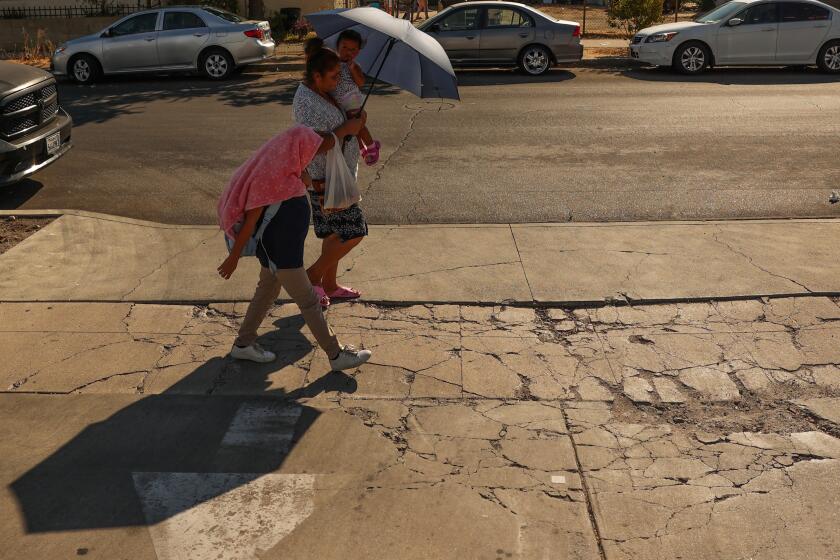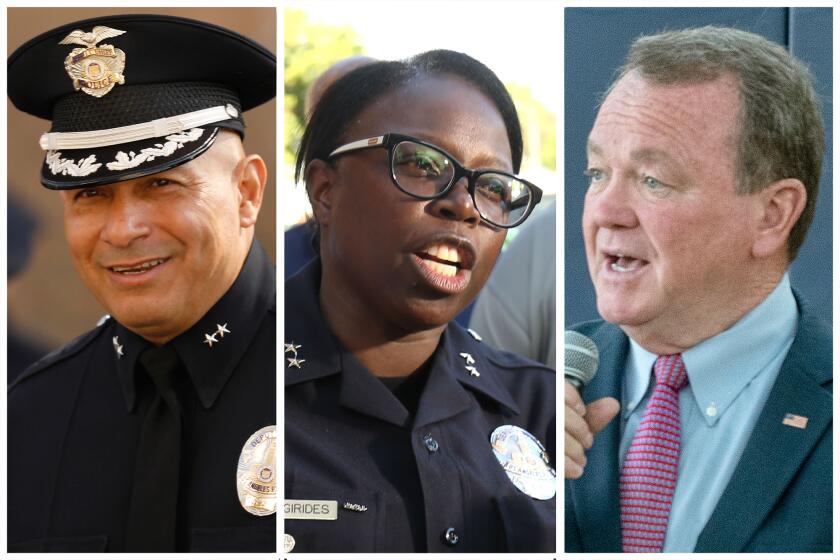Still Just a Flicker : Women Entered Firefighting Years Ago, but Few Have Joined Them
In the 1986 TV movie “Firefighter,” the first woman to join the Los Angeles County Fire Department blazes a gender-bending trail meant to light a fire under prospective female recruits.
Even though in real life the subject of the film faced hazing that included a sanitary napkin dispenser being thrown at her feet (to which she responded, “That’s not my brand” before stalking out), Cindy Barbee hoped that her 1983 breakthrough would encourage other women to storm the firehouses.
But 11 years later, any sequel to the TV movie about Barbee would be too downbeat to be made. Out of 2,400 county firefighters, only 11--less than half of 1%--are women, one of whom is undergoing a sex-change operation to become a man.
And to the chagrin of county officials, a federal judge recently overturned the Fire Department’s attempt to be sensitive to its female employees: a ban on Playboy magazine and other sexually explicit magazines in fire stations.
The court found that the ban violated constitutional guarantees of free speech and press. The county is appealing the order, which specifically permits “the quiet reading” of Playboy, but some female firefighters fear that a second court defeat would strengthen the male grip on the department by permitting all skin magazines in the stations, including hard-core pornography.
Dismal as the county’s record of hiring female firefighters sounds, the national picture is not that much brighter. Since the first woman became a full-time firefighter 20 years ago in Arlington County, Va., only 4,000 women have joined the ranks. They constitute less than 2% of the 250,000 paid firefighters nationwide.
“It’s still a men’s club, or, as I like to call it, a boys’ club, because some of them aren’t that mature,” said Barbee, who is 38.
It pays to be a member of that club. County firefighters earn at least $35,000 a year for working 10 round-the-clock shifts per month, an annual salary that increases with seniority, promotions and overtime. Last year, Barbee earned $89,000.
Despite the allure of the money, few women succeed at getting hired because they lack the upper-body strength to pass entrance exams that include dragging bulky hoses and lifting heavy ladders. Fewer women than men apply anyway, and when they do, their failure rate is much higher. In the county’s last physical exam for the firefighter trainee program, almost half of the hundreds of male applicants passed, while only six women--or 16.6% of the 36 who tried--made it.
Firefighting is one of the few professions in which technology has not necessarily made the job less physically taxing.
Despite the introduction of some automated equipment, firefighters need to be stronger than ever because the modern gear they wear--including oxygen tanks that resemble scuba equipment and weigh nearly 40 pounds--is heavier. But just how much strength is necessary to do the job and whether mandatory physical entrance exams are designed fairly are central questions in the debate over how to bring more women into fire service.
“No one agrees on how much strength you need and how you measure it,” said Terese Floren, executive director of Women in Fire Service, an international trade association. “Every citizen who pays taxes has a right to expect firefighters who are competent to do the job. The question is how strong is strong enough? If you (overemphasize) one aspect, you’re going to miss out on others, like teamwork and intelligence.”
In San Diego, where women make up 8% of the Fire Department--among the highest proportions in the nation--a spokesman said women have improved life in the firehouse for everyone. Women are responsible for the fact that most modern fire stations have semiprivate sleeping areas instead of large, communal dormitories, said San Diego Capt. Bob Zepeda.
Several major departments have managed to hire a larger percentage of women than Los Angeles County, largely because they have changed their physical tests and training programs, prompted in some cases by affirmative action lawsuits.
*
The city of Los Angeles, which was under a federal consent decree in the mid-1970s to increase the number of minorities in its Fire Department, eventually started actively recruiting women to avoid being sued, officials said.
The city has 53 female firefighters--2% of the force--many of whom participated in a special training program run by the department to get women in shape for the physical test. But a spokesman said the department may soon eliminate the 10-week program or find private funding to pay the $45,000-per-session cost because of fear of a lawsuit by male firefighters who have formally complained that it is discriminatory to spend public dollars to train only one gender.
Los Angeles County has never made a special effort to train women to take the test. Officials say the county cannot afford to provide such programs.
The handful of female county firefighters who agreed to be interviewed said they support more aggressive efforts to recruit women, but oppose offering special training programs or making the physical test easier because they believe strength is an important qualification.
Capt. Deborah Lawrence, the highest ranking woman in the county Fire Department, said she had no trouble passing the physical test seven years ago when she decided to switch from nursing to firefighting.
“You don’t have to be superhuman,” said Lawrence, who is a muscular, 5 feet 7 1/2 inches tall and weighs 135 pounds. “Women can do it if they get in shape, but you have to want it, you have to commit yourself to training hard, and you have to do it for the rest of your life.”
Lawrence, 38, said her upbringing probably helped her succeed. Her parents treated her and her three younger brothers equally, she said.
Physical weakness is not the only reason women have not broken into fire service in great numbers, firefighters say. Even strong women may be deterred by the lack of privacy in older stations that have communal dormitories and bathrooms, by grooming standards that until recently called for military-style men’s haircuts for women and by the sometimes hostile working environment.
“You’re definitely working in a fishbowl, and there are people that want to see you fail,” said Janet Babcock, 31, the third woman to join the county Fire Department. “I’ve seen guys drop ladders, but no one talks about that. You hear about it if you’re a girl.”
Male and female firefighters agreed that the days are long gone when sexist incidents were common, like the one in which a fire captain threw the sanitary napkin dispenser at Barbee’s feet in a fit of pique shortly after she joined the department. “The way things are now, if you get out of line, there’s a lawyer waiting in the wings,” said Los Angeles County Firefighter Rick Ortiz, 41. The county department still does not have a women’s locker room in its training academy in East Los Angeles, much to the consternation of female trainees. Unlike men, who have a large room with showers and lockers, female trainees have to scramble down to the basement to use a small restroom with a shower during the brief periods recruits are given to change clothes.
Department officials cited limited financial resources, but a new battalion chief in charge of training has recently pledged to find the money.
Barbee and Inspector Jerilynn Haertsch, another county firefighter, also are trying to get the department to force its supplier to make uniforms for women. Now, female firefighters have to either make do with baggy, ill-fitting uniforms cut for men, make expensive alterations or spend their own money on properly fitting clothes, they said.
*
But ill-fitting uniforms and unequal facilities pale by comparison to the physical test as deterrents for women.
Like night and day, San Diego and New York illustrate how differences in those physical tests affect the composition of a fire department.
In New York City, applicants are ranked primarily according to how fast they complete events such as climbing stairs while wearing heavy gear. Men beat women in most events, so they are hired first. The department hired its first woman in 12 years this summer.
To get women in shape for the New York test, female members of the department recently helped raise $75,000 from private sources for a pre-training fitness program.
At the other end of the spectrum, San Diego changed its physical test in 1977 in response to an affirmative action lawsuit. Among other things, the department abolished height and weight requirements, and eliminated such events as having to lift a ladder overhead five times consecutively, Zepeda said.
“There has been absolutely no decline in our safety record or the quality of our applicants,” Chief Robert Osby said. “If anything, it’s been the opposite.”
Women on the Fire Lines
Twenty years ago, a woman in Arlington County, Va., became the first female, full-time, paid firefighter in U.S. history. Today, fire service remains a male-dominated occupation:
Location Number of Women/Total % of Women * Nationwide 4,000 out of 250,000 1.6% * L.A. County 11 out of 2,400 Less than 1% * L.A. city 53 out of 2,700 About 2% * San Diego 71 out of 851 About 8% * San Francisco 73 out of 1,459 5% * New York 36 out of 11,234 Less than 1%
Sources: Fire departments, Women in Fire Service
More to Read
Sign up for Essential California
The most important California stories and recommendations in your inbox every morning.
You may occasionally receive promotional content from the Los Angeles Times.










